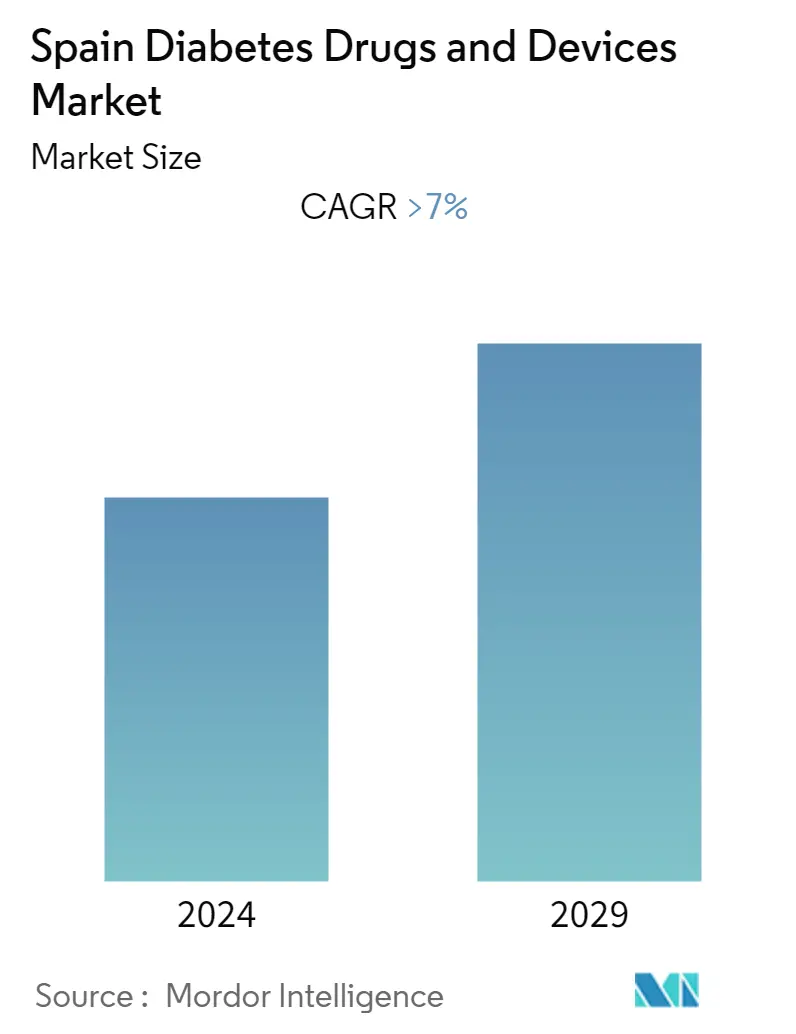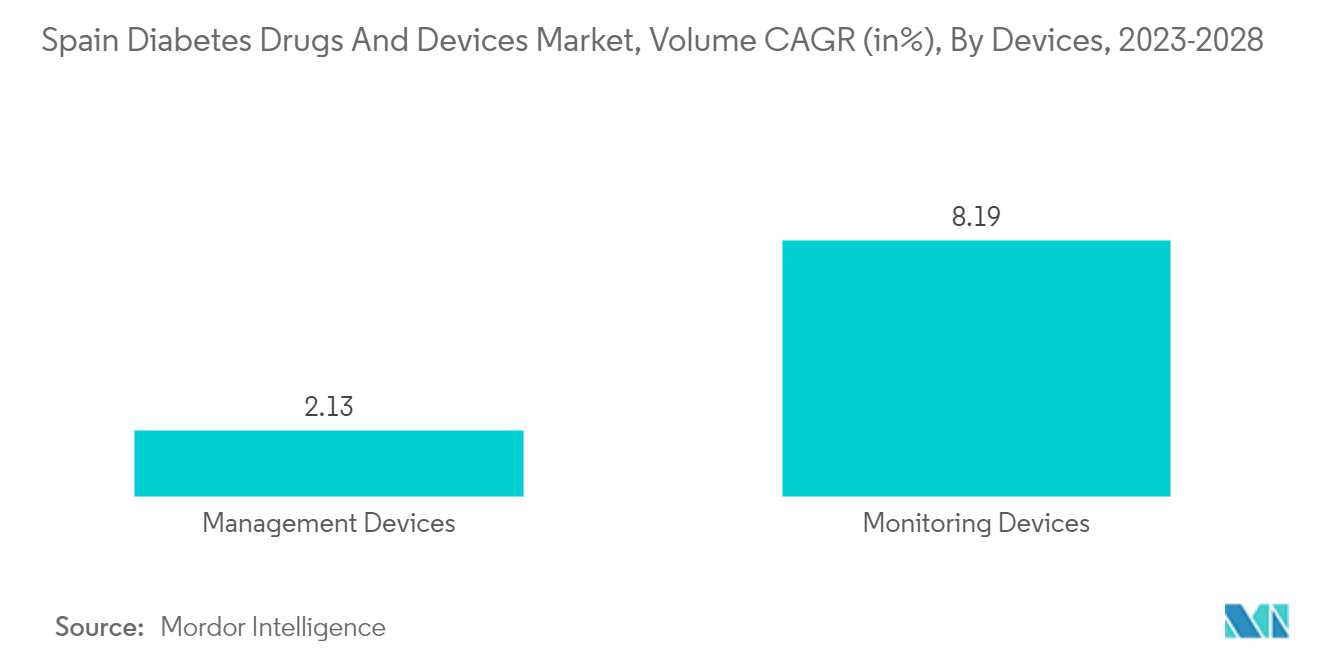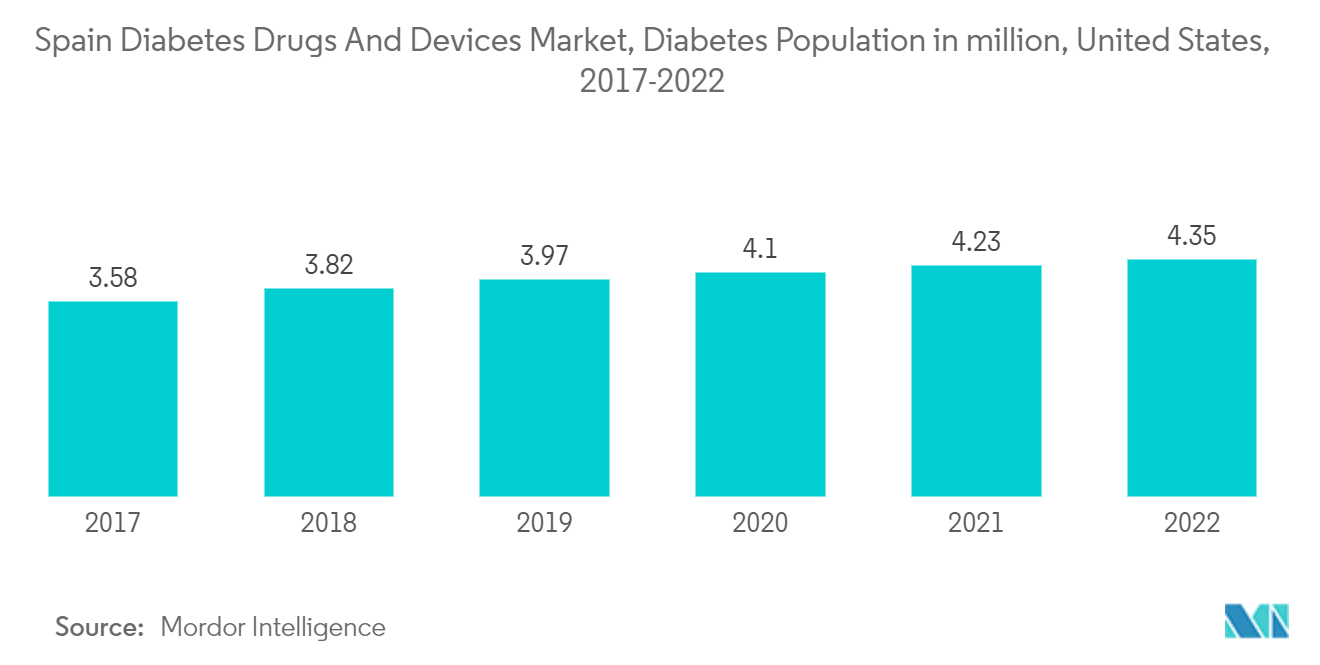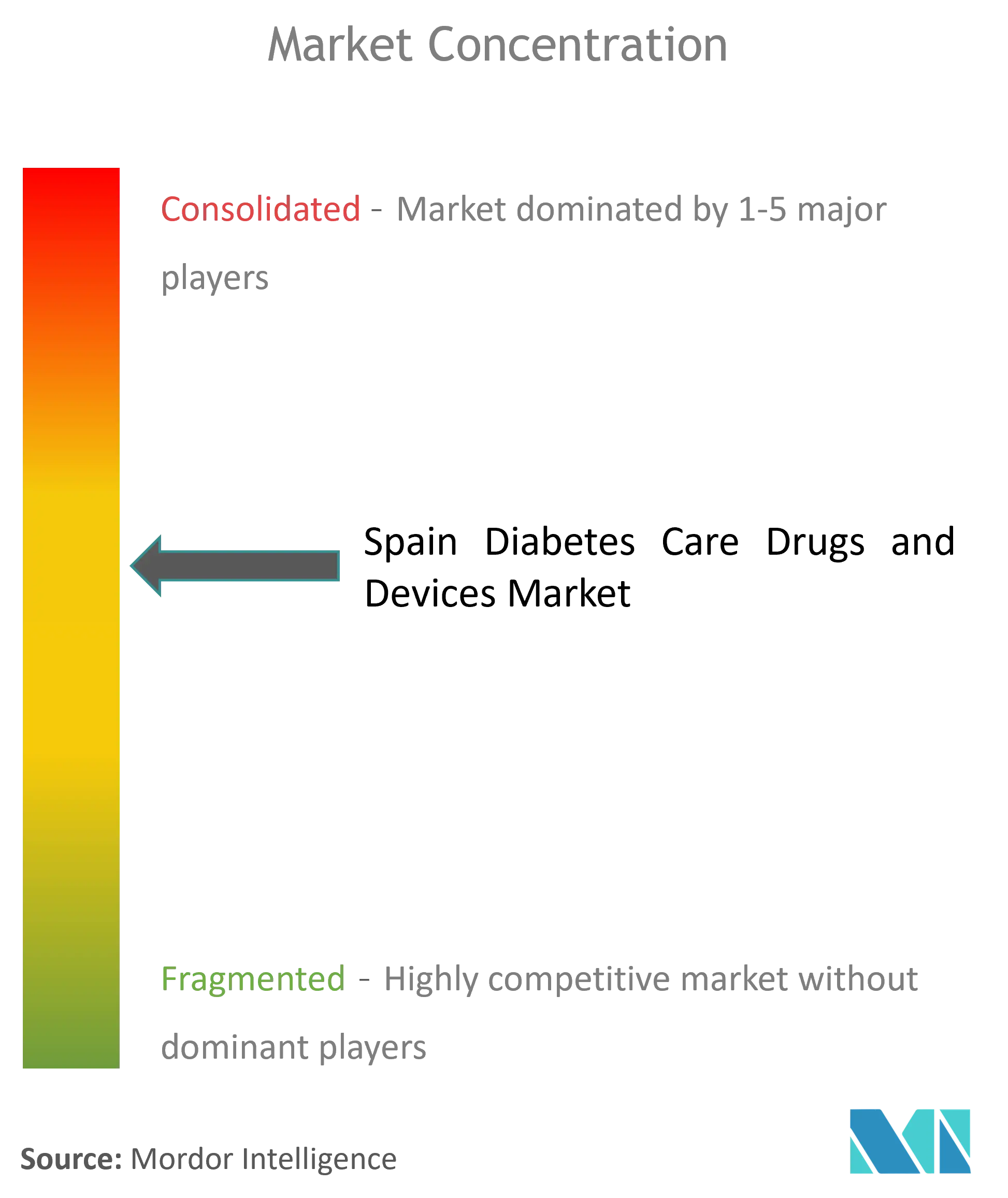Spain Diabetes Drugs and Devices Market Size

| Study Period | 2018 - 2029 |
| Base Year For Estimation | 2023 |
| Forecast Data Period | 2024 - 2029 |
| Historical Data Period | 2018 - 2022 |
| CAGR | 7.00 % |
Major Players
*Disclaimer: Major Players sorted in no particular order |
Spain Diabetes Drugs and Devices Market Analysis
Spain's diabetes drugs and devices market is estimated at USD 0.7 billion in the current year. The market is expected to reach USD 1.1 billion in five years, registering a CAGR of more than 7.01% during the forecast period.
According to WHO, Spain has administered 102,258,825 vaccine doses as of 25 June 2022. Baseline hyperglycemia significantly predicts all-cause mortality in non-severe COVID-19 patients, regardless of diabetes history. On October 25, the government declared a state of emergency after clinical trials resumed after about four months of easing certain restrictions. This included partial lockdown measures with movement restrictions until May 9, 2021. The COVID-19 pandemic in Spain has forced the government to introduce new laws and restrictions to stop the spread of the virus. Lockdowns have proven to be an effective approach to reducing the risk of infection. For the above reasons, the expansion of the examination market in Spain is predicted.
Insulin drugs are important in treating type 1 diabetes (T1D). Examples of such drugs are insulin drugs. These devices are associated with improved glycemic control and reduced hypoglycemia. In pharmaceuticals, the insulin category holds a significant market share. Worldwide, he has over 100 million people using insulin, including all type 1 diabetics and 10-25% of type 2 diabetics. Insulin production is very demanding, and only a few insulin manufacturers are on the market. Therefore, there is fierce competition among these manufacturers, who constantly strive to meet their patients' needs by providing the highest quality insulin. Medical devices (T1D) are one of the key components in the treatment of type 1 diabetes. Devices include insulin pumps, continuous glucose monitors (CGM), and blood glucose meters. These devices lead to better blood sugar control and less hypoglycemia.
Thus, the above factors are expected to drive market growth over the forecast period.
Spain Diabetes Drugs and Devices Market Trends
The continuous Glucose Monitoring Segment is Expected to Witness the Highest Growth Rate Over the Forecast Period
Continuous blood glucose monitoring (CGM) and multiple daily injections (MDI) have been shown to reduce mild and severe hypoglycemia in patients with type 1 diabetes who are prone to this side effect. People with type 1 diabetes who are at high risk of hypoglycemia can use self-contained continuous blood glucose monitoring, even in dire living conditions imposed by the stringent lockdowns imposed by the COVID-19 pandemic crisis. It may regulate blood sugar levels. Glucose metrics improved slightly during the lockdown period, particularly glucose tolerance-related ones, leading to relief measures.
People with type 1 diabetes (T1D) need to maintain a healthy lifestyle depending on their personality traits, social interactions, socioeconomic status, and living environment factors. The use of continuous glucose monitoring (CGM) with multiple daily injections (MDI) has been shown to reduce non-severe and severe hypoglycemia in type 1 diabetic patients who are prone to this side effect. Patients with type 1 diabetes, at high risk of hypoglycemia, control their blood glucose levels thanks to self-contained continuous blood glucose monitoring, even under harsh living conditions imposed by strict lockdowns due to the COVID-19 pandemic crisis. Small improvements in blood glucose measurement markers, especially those related to glucose tolerance, were associated with the lockdown period. Spanish hospitals have ordered CGM machines to limit staff contact with most COVID-19 diabetic patients. Decisions taken by national bodies such as the Italian Ministry of Health and Spain's Spanish Medical and Health Agency were very limited in scope. These organizations typically have the power to withdraw or reject products but rarely use them for new devices. Spain has the second highest diabetes prevalence in Europe; Spain is also among the top 10 countries in spending on diabetes-related healthcare, with a total of USD 15.5 billion.

Rising diabetes prevalence
In Spain, the number of people with type 1 diabetes is increasing, recording an annual growth rate of more than 3% during the forecast period. Up to 13.8% of adults in Spain have diabetes, and about 6% are believed to have undiagnosed diabetes. A similar prevalence has been identified in the Valencia region of Spain, with a population of 5 million. In this area, general practitioners monitor most diabetic patients and work closely with endocrinologists to treat more complex cases. Many papers point out that people with diabetes are more likely to develop severe COVID-19 infections, have worse outcomes, and have higher mortality rates. The SED expects the death rate to rise further, as the non-diabetic population has a mortality risk of between 0.9% and 3%. Spanish citizens with diabetes are estimated to have a mortality risk of around 7.3%. In Spain, 30.3% of diabetic patients have never been diagnosed. If not properly recognized and treated, diabetes can lead to serious and sometimes fatal consequences such as heart attack, stroke, kidney failure, blindness, and lower limb amputation. They impair the quality of life and increase medical costs.
According to the Spanish Diabetes Association (SED), therapeutic education about diabetes has evolved from a necessity to a priority and an urgency. With the relentless rise in cases and important advances in disease control and treatment, educational efforts with essential equity measures have so far been required to facilitate access to these new resources for all people with diabetes. More is required. SED also recognizes important advances made in the management of diabetes, particularly through technological advances. For example, it approved funding for a flush system for her type 2 diabetic patients on bolus basal insulin therapy.
Suppose diabetes is not diagnosed or adequately treated. In that case, people with diabetes risk serious and life-threatening complications such as heart attack, stroke, kidney failure, blindness and lower limb amputation. This leads to a lower quality of life and higher healthcare costs, resulting in a greater need for access to healthcare. Evidence suggests that diabetes can be successfully managed, especially if detected early. Multicomponent interventions, including glycemic, blood pressure and lipid control, can reduce a wide range of micro- and macrovascular complications and early mortality associated with diabetes.

Spain Diabetes Drugs and Devices Industry Overview
Manufacturers have constantly innovated to survive in the market. Large companies such as Abbott and Medtronic have made numerous mergers, acquisitions, and partnerships to gain market dominance while adhering to organic growth strategies. The manufacturers of insulin delivery devices are spending a huge amount on the R&D of the devices. For example, Novo Nordisk partnered with Abbott Diabetes Care, which may also assist to enable insulin statistics to be shared between Novo Nordisk-connected insulin pens and digital fitness equipment well suited to the FreeStyle Libre portfolio of products. Mega Blockbuster Lantus, manufactured with the aid of Sanofi, led the basal insulin field.
Spain Diabetes Drugs and Devices Market Leaders
-
Medtronics
-
Roche
-
NovoNordisk
-
Sanofi
-
Omnipod
*Disclaimer: Major Players sorted in no particular order

Spain Diabetes Drugs and Devices Market News
- November 2022: The Eversense E3 continuous glucose monitor (CGM) was approved by the FDA and it received a CE Mark approval in Europe for people with diabetes aged 18 and older.
- March 2022: Novartis announced that the European Commission (EC) approved Beovu (brolucizumab) 6 mg for the treatment of visual impairment due to diabetic macular edema (DME). The EC decision applied to all 27 European Union (EU) member states, including Spain, as well as Iceland, Norway, and Liechtenstein.
Table of Contents
1. INTRODUCTION
- 1.1 Study Assumptions and Market Definition
- 1.2 Scope of the Study
2. RESEARCH METHODOLOGY
3. EXECUTIVE SUMMARY
4. MARKET DYNAMICS
- 4.1 Market Overview
-
4.2 Market Dynamics
- 4.2.1 Market Drivers
- 4.2.2 Market Restraints
-
4.3 Porter's Five Forces Analysis
- 4.3.1 Bargaining Power of Suppliers
- 4.3.2 Bargaining Power of Consumers
- 4.3.3 Threat of New Entrants
- 4.3.4 Threat of Substitute Products and Services
- 4.3.5 Intensity of Competitive Rivalry
5. Market Segmentation (Market Size by Value - USD)
-
5.1 Devices
- 5.1.1 Monitoring Devices
- 5.1.1.1 Self-monitoring Blood Glucose Devices
- 5.1.1.2 Continuous Blood Glucose Monitoring
- 5.1.2 Management Devices
- 5.1.2.1 Insulin Pump
- 5.1.2.2 Insulin Syringes
- 5.1.2.3 Insulin Cartridges
- 5.1.2.4 Disposable Pens
-
5.2 Drugs
- 5.2.1 Oral Anti-Diabetes Drugs
- 5.2.2 Insulin Drugs
- 5.2.3 Combination Drugs
- 5.2.4 Non-Insulin Injectable Drugs
6. Market Indicators
- 6.1 Type-1 Diabetes Population
- 6.2 Type-2 Diabetes Population
7. COMPETITIVE LANDSCAPE
-
7.1 Company Profiles
- 7.1.1 Novo Nordisk
- 7.1.2 Medtronic
- 7.1.3 Insulet
- 7.1.4 Tandem
- 7.1.5 Ypsomed
- 7.1.6 Novartis
- 7.1.7 Sanofi
- 7.1.8 Eli Lilly
- 7.1.9 Abbottt
- 7.1.10 Roche
- 7.1.11 Astrazeneca
- 7.1.12 Dexcom
- 7.1.13 Pfizer
- *List Not Exhaustive
- 7.2 Company Share Analysis
8. MARKET OPPORTUNITIES AND FUTURE TRENDS
** Subject To AvailablitySpain Diabetes Drugs and Devices Industry Segmentation
A few of individuals with type 1 and type 2 diabetes can benefit from using a CGM. Those who would benefit the most are individuals that have trouble reaching and maintaining target blood glucose levels. CGMs are especially useful if they frequently have lows and aren't aware of when they occur (hypoglycemia unawareness). Spain diabetes drugs and devices market segmented by drugs (insulin, oral anti-diabetic drugs, non-insulin injectable drugs, and combination drugs), and devices (management devices, insulin pumps, insulin pens, syringes, cartridges, and jet injectors, and monitoring devices, self-monitoring blood and continuous glucose monitoring). The report offers the value (in USD) and volume (in unit) for the above segments
| Devices | Monitoring Devices | Self-monitoring Blood Glucose Devices |
| Continuous Blood Glucose Monitoring | ||
| Devices | Management Devices | Insulin Pump |
| Insulin Syringes | ||
| Insulin Cartridges | ||
| Disposable Pens | ||
| Drugs | Oral Anti-Diabetes Drugs | |
| Insulin Drugs | ||
| Combination Drugs | ||
| Non-Insulin Injectable Drugs |
Frequently Asked Questions
What is the current Spain Diabetes Drugs and Devices Market size?
The Spain Diabetes Drugs and Devices Market is projected to register a CAGR of greater than 7% during the forecast period (2024-2029)
Who are the key players in Spain Diabetes Drugs and Devices Market?
Medtronics , Roche, NovoNordisk, Sanofi and Omnipod are the major companies operating in the Spain Diabetes Drugs and Devices Market.
What years does this Spain Diabetes Drugs and Devices Market cover?
The report covers the Spain Diabetes Drugs and Devices Market historical market size for years: 2018, 2019, 2020, 2021, 2022 and 2023. The report also forecasts the Spain Diabetes Drugs and Devices Market size for years: 2024, 2025, 2026, 2027, 2028 and 2029.
Spain Diabetes Drugs and Devices Industry Report
Statistics for the 2024 Spain Diabetes Drugs and Devices market share, size and revenue growth rate, created by Mordor Intelligence™ Industry Reports. Spain Diabetes Drugs and Devices analysis includes a market forecast outlook to for 2024 to 2029 and historical overview. Get a sample of this industry analysis as a free report PDF download.



